
This article was originally published on October 4, 2022 on The Restless Viking website.
The loneliest lighthouse, Waugoshance, located 15 miles west of Mackinaw City, crumbles under feathered friends. After standing guard for over 170 years, Waugoshance Crib Light is now slowly collapsing into Lake Michigan. Join us on our exploration in Thor as we take an up close look-see at this magnificent piece of history and answer the question, “Why did the United States bomb this lonely crib light?”
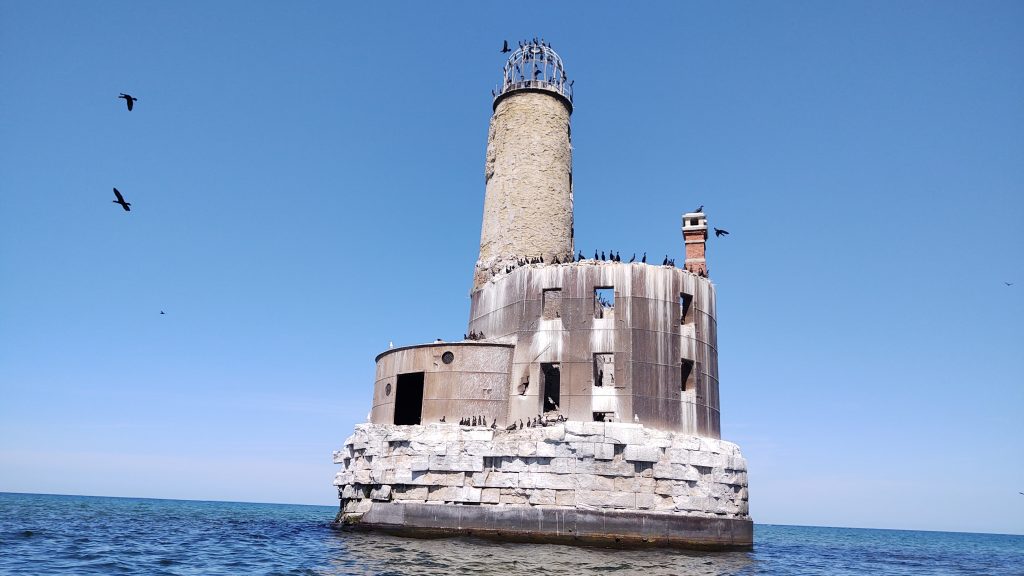
The Cormorants greeted us with ceaseless calls. As we neared the lee side of the monolith their penetrating odor stung the back of my throat. I coughed as I pointed out shallow rocks to my husband, Chuck, as he navigated over the shoal. How did people build this lighthouse in the middle of Lake Michigan? Why would the government choose to bomb it’s own structure? I needed to know more about this impending monument standing alone in Lake Michigan.
The History of Waugoshance
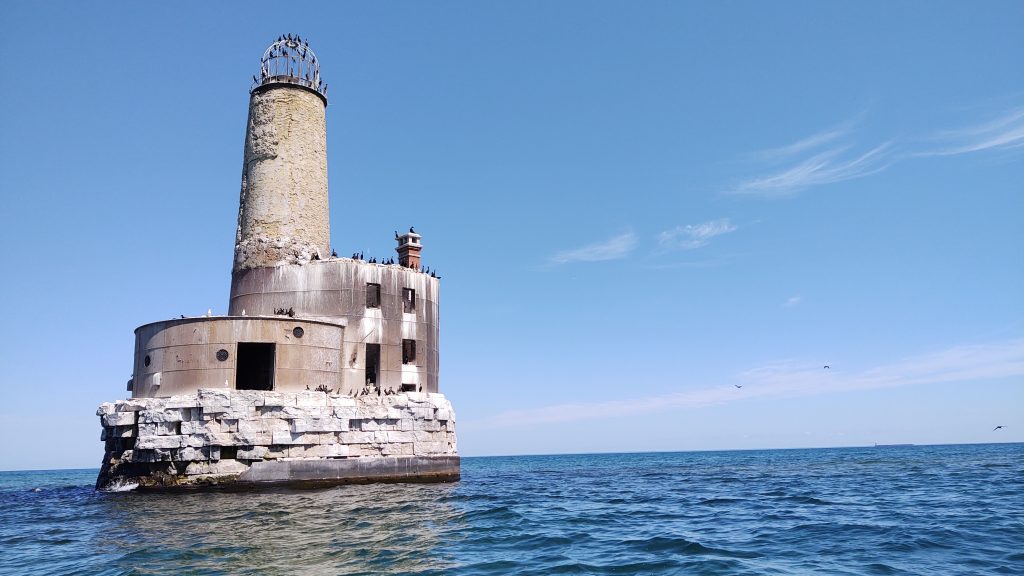
Built in 1850 (That’s BEFORE the Civil War!) and first lit in 1851, Waugoshance Light replaced the Lois McLain. She had been the “light vessel” anchored over this shoal beginning in 1832. I marveled at this 172 year old structure and the people who had brought her to life. They did this without the benefit of cranes or large machines! Wow!
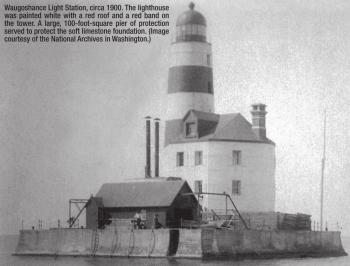
Waugoshance Light Station 1900
The base, called a ‘crib,’ had been built on nearby St. Helena Island under the direction of Captain Augustus Canfield. The wooden crib was floated to the location over the shallow shoal and sunken using large boulders. The cement crib was built over this foundation. Bricks were used to construct both the tower and the keeper’s quarters. By 1851 the light was put into service, protecting ships from the dangerous shoal.
A head keeper and two assistants worked tirelessly to keep the lights burning. Sadly, one head keeper, Thomas Marshall, drowned in 1886. John Herman, another head keeper, was known for shenanigans. He even locked an assistant in the lantern room as a joke. When the assistant finally managed to free himself, he couldn’t find John. It was suspected that after indulging in ‘spirits,’ John had fallen off the crib and drowned. John was never found. Since then, “John Herman’s ghost” has been blamed for any noises or disturbances at Waugoshance.
With the winter ice and contrasting summer heat Waugoshance was already showing wear by 1879. Steel wrappings were added to the structure. Plans were being drawn up to build White Shoal Lighthouse nearby. On September 1, 1910 White Shoal Crib Lighthouse had been activated. By 1912 Waugoshance was deactivated and abandoned.
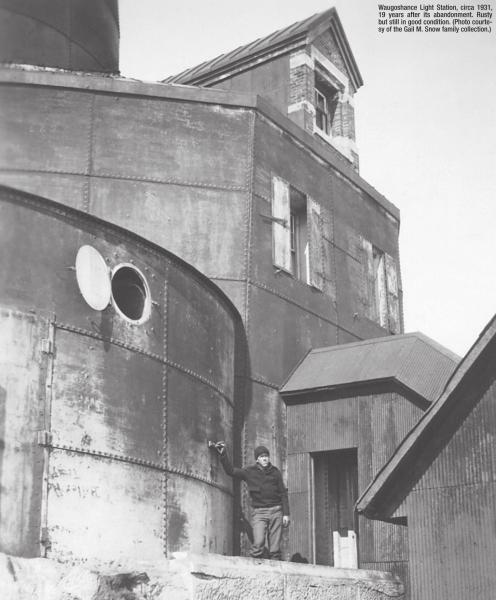
Photo Credit: Gail Snow 1930 After being abandoned for nearly two decades, people took ‘self-guided tours’ of Waugoshance Light.
The Forgotten Flight Decks of the Great Lakes
So, when did we start bombing Waugoshance? Well, it all began with the catalyst of Japanese Kamikaze pilots during World War II. These Japanese men would fly directly into the flight deck of our aircraft carriers destroying them as well as themselves. The United States needed a plan to combat this new type of warfare.
Due to U-boats, the oceans were unsafe for training. So, it was decided that Lake Michigan would be ideal. However, the aircraft carriers at that time wouldn’t fit through the Erie Canal. Something needed to be done quickly!
Within four months, the top cabins of two luxury liners were removed. Each ship received a five hundred foot, wooden flight deck.
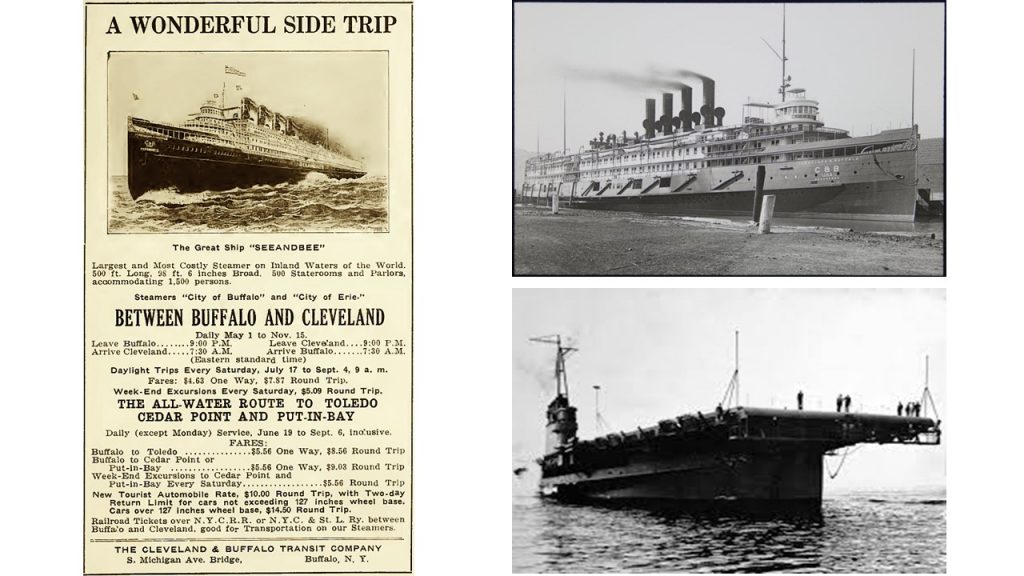
Two luxury liners, “The Greater Buffalo” and “The Seeandbee” were transformed into
steam powered aircraft carriers. The vessels were renamed, “USS Sable” and “USS Wolverine.”
Pilots would take off from Glenview Airport (just outside Chicago) and practice landing on these short, wooden strips bobbing in the middle of Lake Michigan. The pilots would taxi to an elevator platform, fold their plane’s wings and be lowered to the ‘hanger deck’ where they could be transported back to shore.
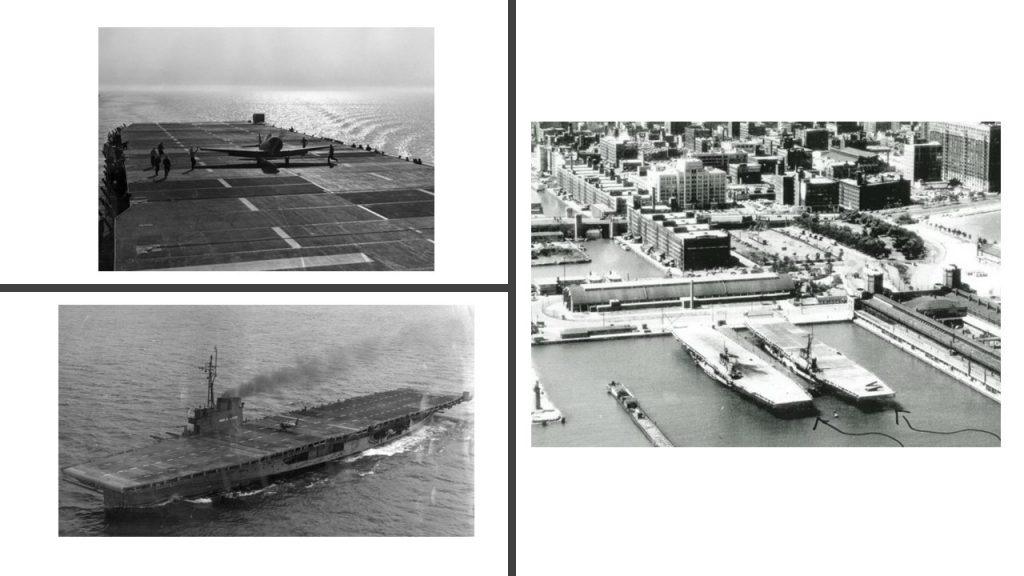
(Left) Pilots practiced landing on the wooden decks. (Top: USS Sable) (Bottom: USS Wolverine) (Right) USS Wolverine and USS Sable in port at Chicago’s Navy Pier.
Seven days a week, 17,820 qualified pilots worked with the wind and the waves to navigate 116,000 successful landings. This included future President George H.W. Bush.
Sadly there were130 crashes. Over 100 aircraft sank to the bottom of Lake Michigan. Since 2016 only 27 airplanes have been recovered. One is displayed at the Kalamazoo Air Zoo.
So how does Waugoshance Lighthouse fit into this story? Well, these pilots needed to practice bombing a target. Waugoshance, which had been abandoned and was located off shore away from populated areas, made a perfect objective!
The Secret Stag-1 Drone Program
David Sarnoff, of RCA radio had come up with the idea to construct remotely operated, unmanned planes full of explosives; the first drones. This program was given the secret codename, “STAG-1.”
The USS Sable and the USS Wolverine played an integral role in training pilots to steer these drones. Their target was Waugoshance Lighthouse.
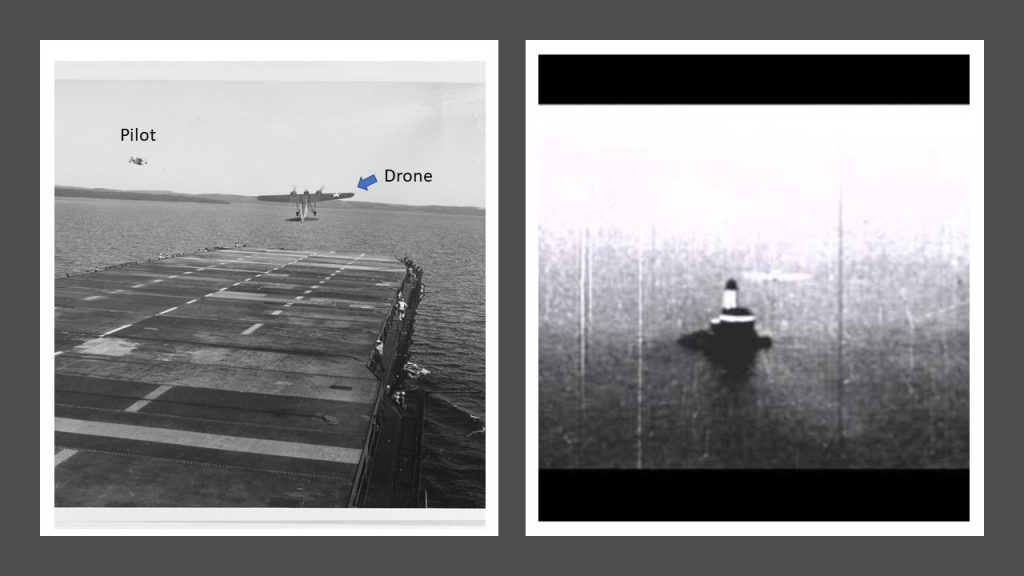
(Left) The pilot controlled the drone from a nearby plane. (Right) A pilot clicked a photograph of a drone flying near Waugoshance Lighthouse.
One bombing of Waugoshance had caused a fire which thoroughly damaged the time honored structure.
For three months this highly secretive program was rehearsed in Lake Michigan. However, drones were only used a few times in the Pacific Ocean before World War II ended.
Sidewinder Missiles
But the bombings didn’t stop there. Between September 1966 and October 1970, at least 279 AIM-QB Sidewinder missiles were fired in the name of practice toward Waugoshance and the surrounding area. This zone had been labeled “Range 6903.”

AIM 9 Sidewinder Missile
Photo Credit: How Stuff Works
Fast Forward to 1990 when a fishing vessel from Sheboygan, Wisconsin was about eight miles offshore and pulled up an unusual metal cylinder in their net. The crew set the eight foot long item on the dock. Soon some men moved it out of the way to the shore where it sat for nearly a year.
Finally on April 25, 1991, an Army ordnance disposal team from Fort Sheridan, Illinois inspected the mysterious specimen. It was deemed still viable. The team quickly packed it up and took it with them. Police Captain John Theune reported that the “officials had no idea where the Sidewinder missile had come from or how it had gotten into the lake.”
Clean Up 2005
A decade and a half later, teams came to ‘clean up’ the area surrounding Waugoshance, “Range 6903.” Using metal detectors and disarming equipment, bombs were located and detonated safely.
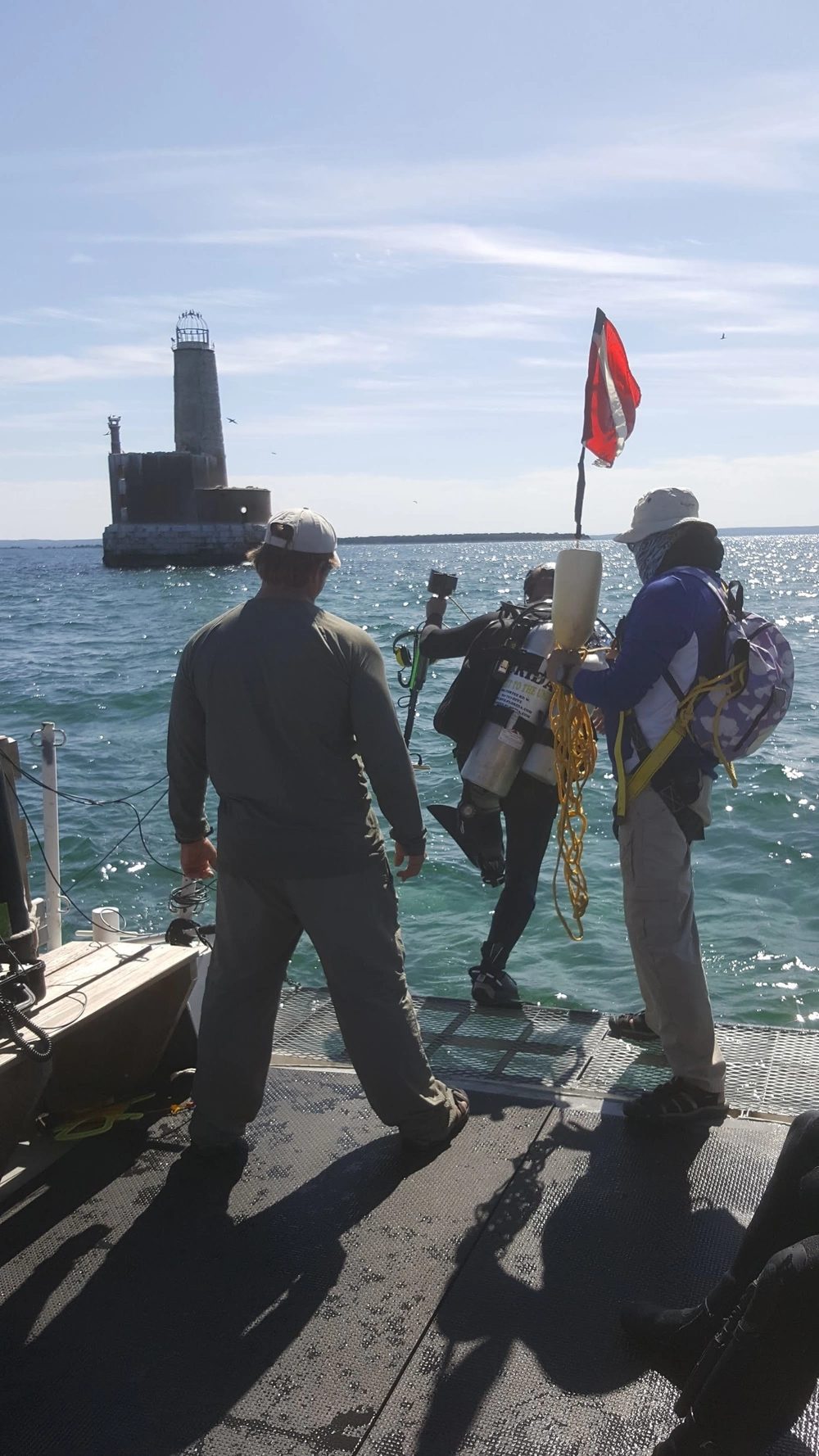
Waugoshance Light watched as diving teams located and safely detonated left over bombs which had been resting at the bottom of Lake Michigan.
It was unsettling to think about ‘viable bombs resting’ along these routes! This made me shudder as we’d traveled this area many times with our children, Charlotte and Noah. Not to mention many other boaters who enjoy Lake Michigan! YIKES!
Our Visit in July 2022
With costs soaring and repairs being extensive, the Waugoshance preservation group disbanded in January 2021. DaViking and I wanted to venture out to witness this marvel of endurance. At nearly two centuries old, built before the Civil War and tolerating bombings, Waugoshance still stands proudly against all odds.
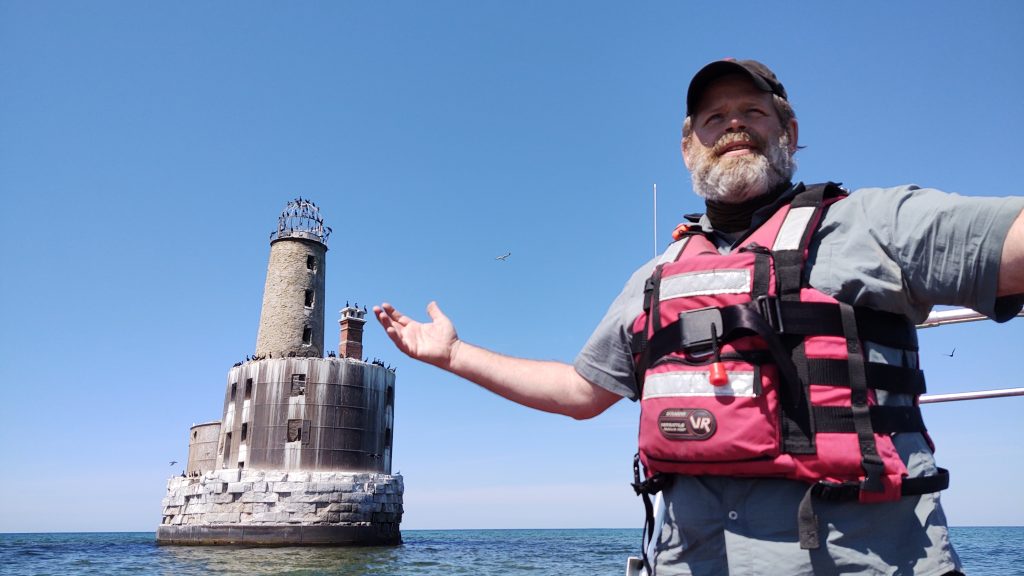
Chuck and Martha Hayden, aka The Viking and Poppins, enjoy going on adventures off the beaten path. They also like to share their explorations with others. The Viking is a retired expedition leader while Poppins is a retired teacher. The two offer independent views of their journeys showcasing places, people, and cultures as they explore the world. Visit and follow them on their website and social media accounts. Website | Facebook | Instagram |YouTube

Leave a Reply